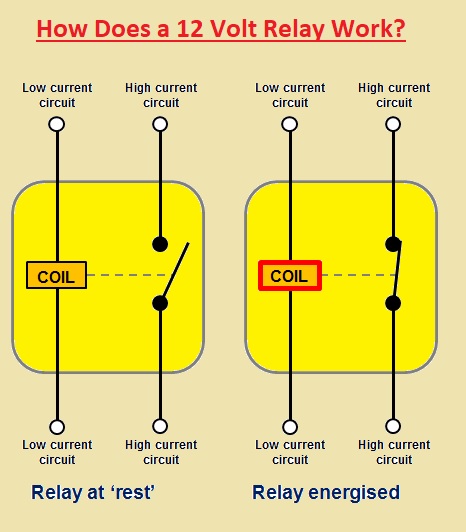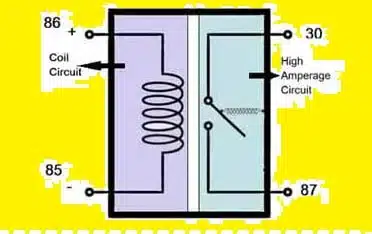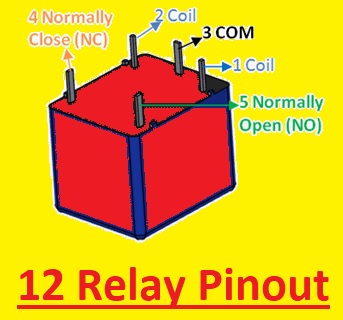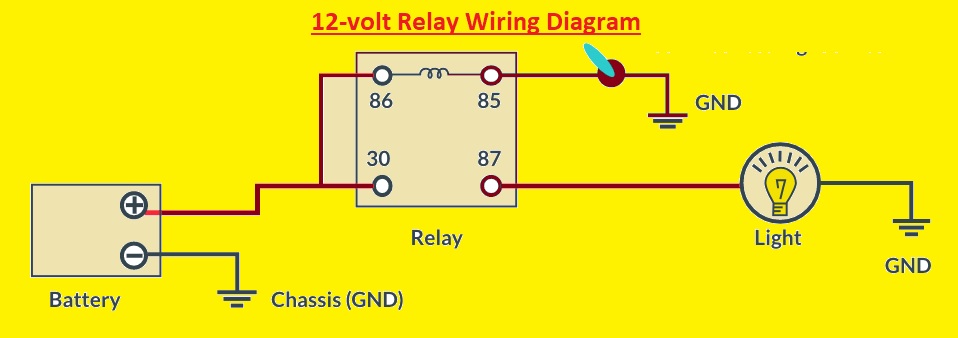Hello readers welcome to the new post. In this post, we will have a detailed look at the 12 Volt Relay. The electrical relay is a heavy-duty remote control switch that has features to handle high-current devices. Relays connected between power supply and electrical devices need power for on and off. When really get energized, current for operating devices passes from the power supply, through the relay, and to the component. In this post, we will have a detailed look at 12V relays and also cover their different parameters like working, wiring, etc. So let’s get started with Introduction to 12 Volt Relay
Introduction to 12 Volt Relays
- Realy is an electrically operated switch that uses an electromagnet for control of current flow in circuitry. It regulates the high-power circuits with the use of fewer power signals so it is used for differnt projects and devices.
- The full form of DPDT is Double Pole Double Throw Relay is an electromechanical control the 2 independent circuits with one control signal.
- It has 2 sets of NO contacts and 2 sets of NC contacts that offer reliable circuit configuration.
- This relay easily switches between two differnt circuits to control them
What is a Relay?
- The relay is switch that operated electrically then mechnically. Though there are many relay designs the commonly used is low voltage auto and marine uses are electro-mechanical relay operated through the activation of electromagnets for pulling contacts to make and break circuits. They are used in vehicles’ electrical systems
How Does a 12 Volt Relay Work?
A car relay is a 12-volt relay that works on the principle of electromagnetism. When the curent moves to the relay it generates an electromagnetic field for attracting the movable rod for making connections.
To understand the relay working for producing the field let’s suppose the relay has two circuits.
One circuit coil circuit and the second is a half circuit or load circuit. Note that the load circuit is controlled through a coil circuit. When current is given to the relay coil circuit, a magnetic field is generated that attracts a movable rod and makes a connection with high ampere circuit.
In this process, the relay is used to switch differnt types of vehicles’ electrical parts.
If we remove the current from the coil circuit, the movable rod move back to the resting position, resulting to disconnect the contact to reduce the current of the high ampere circuit.
According to Faraday law, the change in the magnetic field generates EMF and any change in the flow of current in conductors generates a field about conductors.
When current flows to the relay coil circuit electromagnetic field is produced, which attracts a moveable rod to connect the high ampere circuit of the relay.
All in all the motive of the coil in the relay to bring the movable rod close to the load wire and make high-ampere circuit connections.
12 Relay Pinout Configuration
- Coil End 1= It triggers the relay, one end is connected with 12 volts and the other to the ground.
- Coil End 2= its one end with 12 volts and the other to ground and triggers relay.
- NC: One end of load with No or NC. If connected with NC load is connected before trigger.
- NO: the second end of the load is connected with NO and the load is disconnected before the trigger.
|
Terminal/Pin number |
Connection |
| 85 | Coil |
| 86 | Coil |
| 87 | Normally Open (NO) |
| 87a | Normally Closed (NC) – not present on 4 pin relays |
| 30 | Common connection to NO & NC terminals |
12 Relay Components
Electro-Magnet
- It is the main part of a relay and its work is to generate electromagnetic force for moving the contacts. it is created with coil of wire wrapped on a ferromagnetic core.
Contacts:
- They are electrical connections that open and close control of current flow based on input. They are created with conductive metal like silver or gold and are either normally open relay contacts or NC relay contacts.
Armature:
It is a moveable part of a relay that is attracted through the electromagnetic force of the electromagnet. It is a metallic rod or plate that is connected to contacts, and when the relay is energized it moves to close or open contacts.
Common Terminal:
It is a terminal on a relay that is connected to an electromagnet and get the low current signal that controls the relay.
Normally Open (NO) Terminal:
This terminal connects to NO contact and has a high current when the relay is energized.
Normally Closed (NC) Terminal:
It is connected with NC contact and has a high current when the relay is not energized.
Step-by-Step Guide to 12-volt Relay Wiring Diagram
12-volt relay operates the different accessories in cars and other vehicles. When we apply a small current to the relay coil, this closes contact for feeding power to an accessory that can need high curent for working.
For wiring 12 volt automotive relay there is a need to make 4 connections. There is a need 2 wires to coils so we can operate the relay.
Two more wires are needed to connect the relay contact with the power supply to the devices.
Here process explained for relay wiring
- Make the connection of wires with relay coils. Use two wires from every side of the coil to the positive and negative voltage of the vehicle’s electrical system. Run the wires through the switch, so we can operate the relay
- Make the connection of the common terminal of the battery supply, which can be the same supply providing power to the coil
- Finally, the instrument power lead is connected to the normally open terminal of the relay. When using relay contact will then put voltae on the pin
12 Volt Relay Applications
- The relay is used for the connection of the battery with the starter motor helping the engine to start when the ignition key is on.
- The relay is used to control high current circuit of the fuel pump, helping the low current signal from engine control to run the pump on and off if needed.
- The relay is used to control the high current circuit of an electric fan. helping low current from engine control to fan control.
- It is used in air conditioner compressor systems
- it used to control current for power windows.
- it also used for power seats
Advantages and Disadvantages of 12 Volt Relays
Advantages
- It is used in high-power circuits for controlling low signals
- It has different contacts for easy working.
- it is an effective and reliable device.
- it is easily available
- It used in different vehicles for electrical device controls.
Disadvantages
- It needs high power for energizes which is a waste of energy.
- mechanical contacts have limited working life and need to be replaced.
- it is high weight then solid state.
12V SPDT Relay Specifications:
- Trigger Voltage (Voltage across coil) : 12V DC
- Trigger Current (Nominal current) : 100mA
- Maximum AC load current: 7A @ 250/125V AC
- Maximum DC load current: 10A @ 30/28V DC
- Maximum switching: 300 operating/minute (mechanically)
Working Principle of a DPDT Relay
The relay-insulated coil automatically flips changeover switches when manual switching is difficult. So it operates as a control circuit. Mostly relay uses devices that are like transistors for carrying electrical loads when supply power.
The relay has low voltae used for generating magnetic field from electromagnetic. It also has a contact switch to control the magnetic circuit. For maintaining courses in magnetic field relay works if we flic the button with contact in position.
The DPDT relay comes with a double pole. So its double pole can switch circuits on both side. With that dpdt also has a double throw. This double throw helps to easy switch between wires then just control output through on or off with electric power systems.
What is a 12v Relay Switch?
The 12-volt DC relay switch is best for full voltage applications since it helps low current flow circuits to control high current flow circuits such as a vehicle’s horn, auxiliary lamps, fan motors, headlights, blower motors, and many equipment existing on vehicles
What is a Solid State Relay 12 Volt?
Solid state relays or SSRs are electrical switches that work as electromechanical relays, but without moving parts so known as ‘solid state’. They are the latest semiconductor switches, fulfilling the increasing demand of controlling loads with power regulation features
It is best used for resistive, lamp, and inductive loads.
How Much Voltage Does a 12V Relay Need to Work?
- This relay needed 12 volts, the voltage rating of the relay is based on the voltage level where it operated. The voltage rating defines the accurate operation of the relay.
- If 12 12-volt DC supply is connected with a coil of the relay it produces a magnetic field that operates inner switching, in a result operate opens or loses the contacts. This voltage is used in vehicles and industries where 12 volts are required.
Does Relay Need AC or DC?
- The working of DC relays and AC relays are the same like the electromagnetic principle, but the power supply of DC relays must be DC and the power source of AC relay must be AC supply
Does Relay Need a Battery?
- Relay does not always need a battery to work. Relay can get power through a power source, ac to DC suppliers from circuits.
- The power supply of the relay is based on uses. The relay gets power with vehicle batteries during use.
- it also gets power through the use of ac or dc supply in industries.
- There is a need to consider the voltage and current needed for the relay and load connection when using a power supply for the relay. Make sure the power supply has features to handle the load current and power needed for operating the relay coil.
What is the difference between 5v and 12V relays?
There are main voltage-based relays one is coil operating voltage needed to pull in really and the other is withstand of contact ratings. If there is a 12-volt relay means relay coil voltage for pull-in.
How much power does a 12V relay need?
What is the maximum voltage for a 12V relay?
Can a 12V relay handle 24V?
How many amps does a 12V relay draw?
Will a 12V relay work with 15V?
Can relay work on AC voltage?
Can I use 12v relay with 9v battery?
Read Also:
FAQs
-
How do we determine the appropriate 12-volt relay for my application?
- These factors help to choose the right relay
- Size.
- Switching speed & frequency.
- Mechanical durability.
- Surge current durability.
- Voltage rating.
- Operating environment.
- Isolation between control & load circuits.
- Multiple contacts
-
Is a 12-volt relay handle higher voltage loads?
- No, these relays are created to handle loads in certain voltage value ranges.
-
What is the lifespan of a 12-volt relay?
- The 12-volt relay can handle more than 12 volts for a few seconds only. The relay comes with the coil, when we give 12 volts to the relay curent passes in the coil and the relay works. Insulation of coil and cross-sectional area of conductor of coils is made to handle rated current continuously.
-
Can we use a 12-volt relay in a 24-volt system?
- No, it is not good to use a 12-volt relay for a 24-volt system. it is best to use relay according to rating values
-
Are there any specific maintenance requirements for 12-volt relays?
- Regular cleaning, loose connections, inspection, and replacement of damaged relays are the main factors for the maintenance routine for 12-volt relays
- What is the life expectancy of a 12V relay?
- power relays is generally rated to be 100,000 operations minimum,








